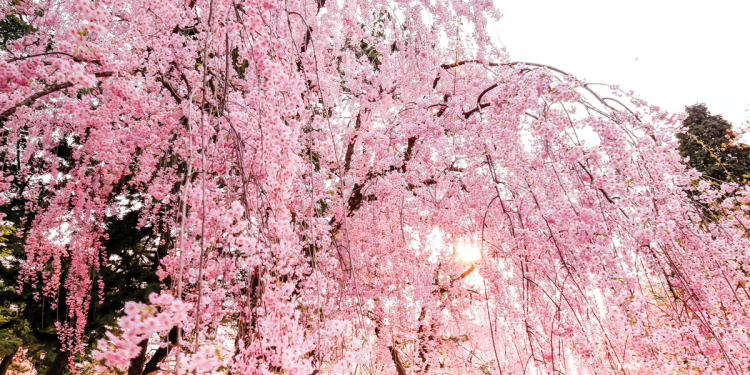Story by William Green, who is an Owensboro native whose passion for plants has led him to visit botanical gardens and natural parks around the world.
On your weekday commute or Sunday stroll around town, take a moment to notice the spring-flowering trees in bloom. Before long, you will likely encounter a gracefully arching specimen, covered in white or pink blossoms that often touch the ground, blowing gently in the breeze. You will have stumbled upon one of nature’s most stunning gifts to the springtime landscape: Prunus subhirtella, the Weeping Cherry.
In its native Japan, the viewing of the cherry blossoms is a national phenomenon called hanami. Millions of people head outside with blankets, picnic baskets, and portable karaoke machines to sing and celebrate the end of winter with friends, family, and even coworkers. Weather reports include information about when the trees will be at their peak bloom. Known as sakura, these beautiful flowers have been a symbol of Japan for centuries. If you’ve ever been to Washington, D.C. in the springtime, you’ll have seen the magnificent Cherry Blossom Festival on the National Mall. These trees were a gift from Japan to the United States in 1912.
The Weeping Cherry is a small but fast-growing tree, which reaches a height of 25 feet after several years. Its branches are long and twisted, which combine with its roughly-textured bark to provide architectural interest to winter gardens. It is worth noting that Weeping Cherry branches are often grafted onto a 5 or 6-foot tall rootstock which, while providing a smooth, straight trunk, limits the total height of the tree and detracts somewhat from its overall appearance. When shopping for one of these trees, be sure to ask whether you are getting the grafted or the full-sized variety.
Several types of Weeping Cherry are available. Prunus subhirtella is the most common in white or pink, while Prunus pendula “Pendula Rosea” is slightly smaller and boasts darker, rose-colored flowers. While tolerant of a wide range of soils, they need regular moisture and won’t do well in dry spots. They can be expected to grow in USDA Hardiness Zones 5-8, so they are right at home here in Owensboro (Zone 6). Generally, these ornamental trees are disease-resistant, but it’s a good idea to keep an eye out for pests such as Japanese beetles and spider mites. In addition to spring flowers, some trees will bloom again in autumn, just before their small, toothed leaves take on handsome shades of red, yellow and orange.
Although it is only one of the wide varieties of spectacular spring bloomers, the Weeping Cherry carries with it a certain dignity that’s hard to achieve with other trees. If you are out and about in early spring, there are many lovely Weeping Cherries in full bloom brightening various Owensboro neighborhoods. Chickasaw Drive, Old Cabin Road, and Griffith Avenue have notable specimens with gracefully arching branches that may inspire you to plant one of these beauties yourself. Give them the little care they need, and it won’t be long before you’ll be inviting your friends and family to experience hanami in your own back yard.










